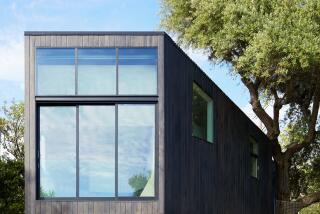LANDMARKS COUNTY HISTORICAL SITES : A. Levy House Was a Family Center
- Share via
HISTORY: The A. Levy House was built in 1912 by Achille Levy, a French immigrant, crop broker and pioneer banker. He and his wife, Lucy, raised four children in Port Hueneme before the bank moved to Oxnard at the turn of the century. The house remained in the family
for almost half a century.
LOCATION: 201 South D St., Oxnard
HOURS: The house may be viewed from the street. For further information, contact the Ventura County Cultural Heritage Board.
The four Levy children were already grown when Achille and Lucy Levy moved from more modest quarters to the shingled bungalow-style home in Oxnard, one of the largest homes in the city. The two-story building was designed by Albert C. Martin, architect of the former Ventura County Courthouse, now Ventura City Hall.
The building’s exterior remains largely unchanged from the original design. A large Craftsman-style front door and an ample front porch supported by columns remain. The porch was used frequently by the Levys, particularly by Achille Levy, who was required by his wife to smoke his cigars outside.
The home was a place of congenial family gatherings, recalled A. A. (Bud) Milligan, grandson of the original owners and third president of the Bank of A. Levy. Two of the three Levy daughters settled in the Oxnard neighborhood when they married, and five grandchildren, including Milligan,
grew up within a few blocks of the home.
“It was a very warm, open atmosphere,” he said, “We were in and out on a daily basis. On Sundays, there was a platter of sandwiches made for lunch.”
Milligan remembers a first-floor sun room, where the children had a special closet to keep their belongings in, and a big, paved back yard where they practiced their tennis swings against the garage doors.
He also recalled a roomy basement with a wine cellar.
“Prohibition came, and they weren’t supposed to have any (wine), but there was some left,” he said.
When the elder Levys died, their bachelor son Joe, second president of the bank, moved into the home and lived there until his death in 1955.
In the ‘60s, the building was converted to apartments. The home gained landmark status in 1982.
More to Read
Sign up for Essential California
The most important California stories and recommendations in your inbox every morning.
You may occasionally receive promotional content from the Los Angeles Times.










